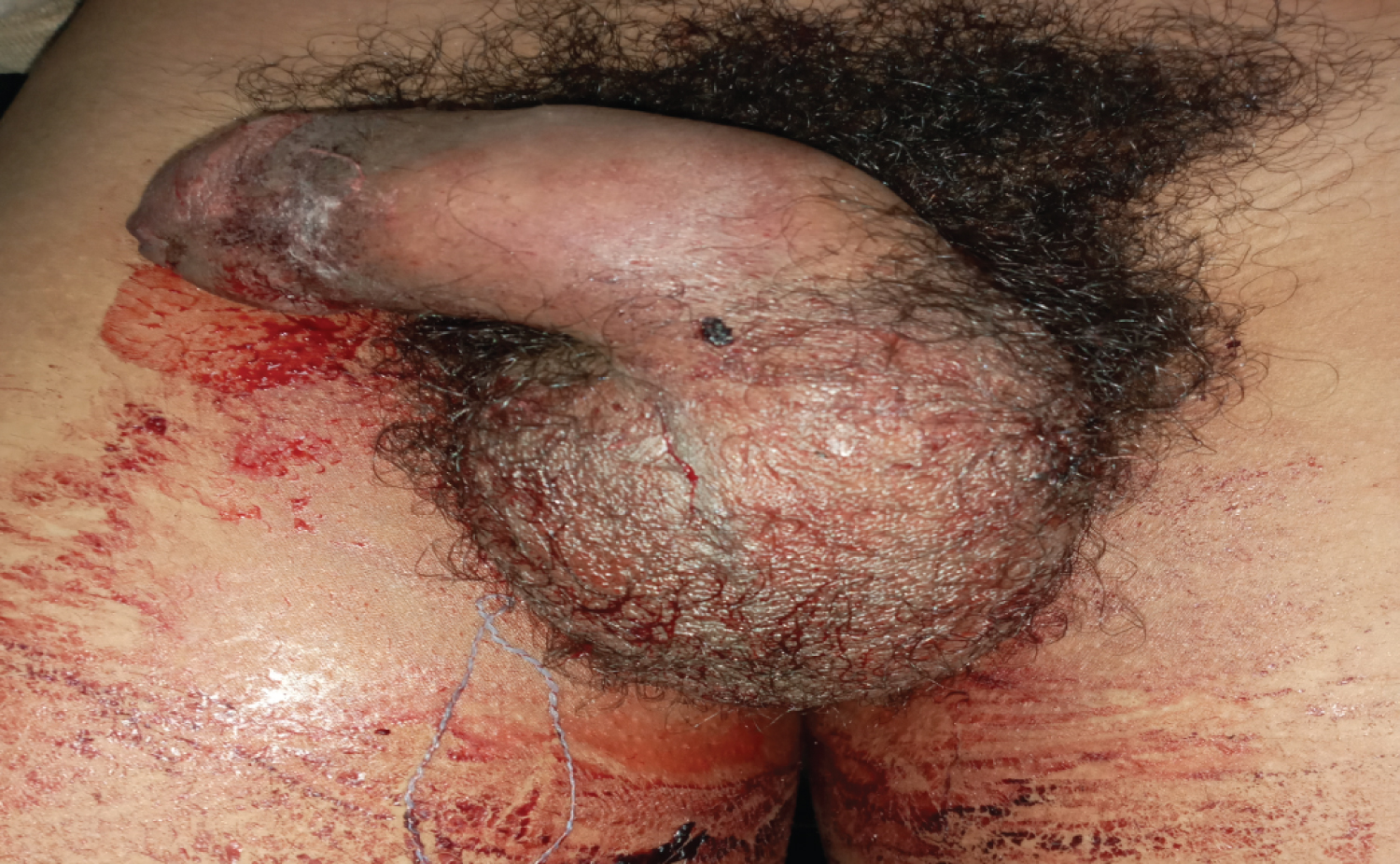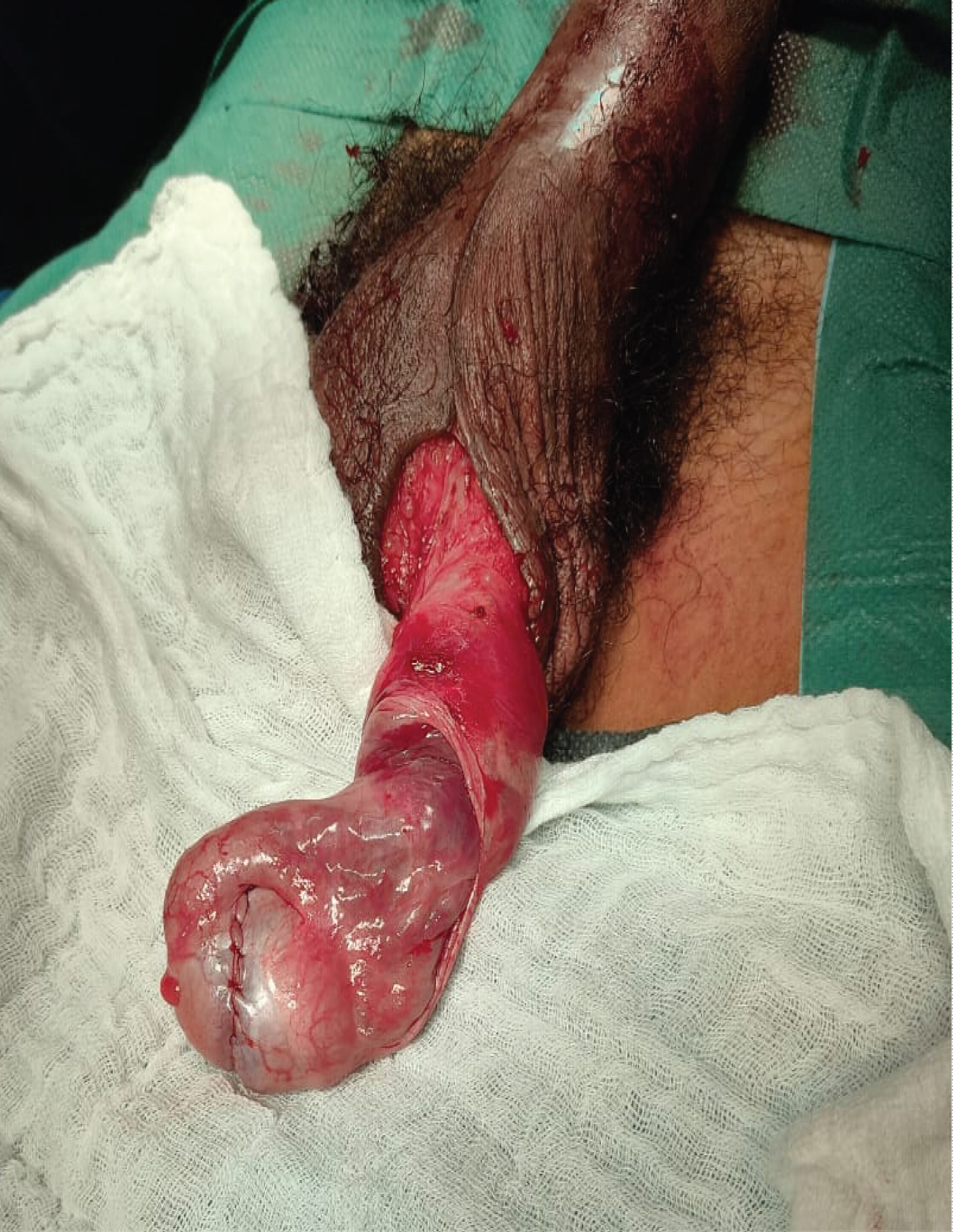External genital trauma due to animals biting is uncommon but it's usually a serious condition counting on the risk of bacterial infection and rabies. The clinical results are usually based on the severity, the duration of post- traumatic consultation and the attitude of management. We are reporting on a 20-years-old adult with no past medical history a victim of severe external genital trauma caused by a domestic dog biting. The clinical presentation was marked by anoozing tendercrotum and urethrorrhagia and the diagnosis were simply made by an urgent scrotal ultrasound showing an abnormal left testicule with a ruptured tunica albuginea and extrusion of testicular content classified to be grade 3 according to the AAST classification for which an urgent surgical decision was taken with an informed signed consent by the family for possible events of orchiectomy.
Bites, Trauma, Scrotum, Testis, Urethroragia
trauma of the male external genital organs by dogs biting is rare with only few cases have been reported in the literature [1] meanwhile people have commonly been savaged by dogs, but genital injuries are rarely reported and most of these types of injuries are being reported in childrens. In the United States bite wounds account for approximately 1% of all emergency visits, of which 60% to 70% were seen in children [2].
This is about a 20-year-old adult without any known past medical history, was a victim of his neighbor’s domestic dog, consulting at our emergency department directly after the incident. the Physical examination of the external genitalia showed an ozzing painful swollen scrotum and urethrorrhagia (Figure 1).
 Figure 1: Ozzing swollen scrotum with urethrorrhagia.
View Figure 1
Figure 1: Ozzing swollen scrotum with urethrorrhagia.
View Figure 1
The reset of the clinical examination was normal. An urgent scrotal ultrasound was requested showing ruptured left testicule classified as grade 3 (Figure 2).
 Figure 2: Ruptured left testicle.
View Figure 2
Figure 2: Ruptured left testicle.
View Figure 2
An emergency surgical exploration of the scrotum showing a ruptured tunica albuginea of the left testicule with bursting of less than 50% of necrotic testicular contents (Figure 3).
 Figure 3: Ruptured tunica albuginea with necrotic contents.
View Figure 3
Figure 3: Ruptured tunica albuginea with necrotic contents.
View Figure 3
Our surgical attitude was to excise the necrotic part of the testicular pulpe, suturing of the ruptured tunica albuginea (Figure 4) and careful dissection and inspection of the bulbo-penile urethra after gental urethral catheterisation looking for possible urethral injuries (Figure 5).
 Figure 4: Suturing of the ruptured tunica albuginea.
View Figure 4
Figure 4: Suturing of the ruptured tunica albuginea.
View Figure 4
 Figure 5: Dissection and inspection of the bulbo-penile urethra after gental urethral catheterisation.
View Figure 5
Figure 5: Dissection and inspection of the bulbo-penile urethra after gental urethral catheterisation.
View Figure 5
The inspection of the urethra was normal andutrthral contusion or abrasion of utrthralmucosa was thought to be the most likely cause of urethrorrhagia.
Passive intramuscular tetanus antitoxin was given to the patient with some other intravenous antibiotics because of the high risk of tetanus and bacterial wound infections. The dog was tested for rabies and proved to be negative, hence the rabies vaccine shots were avoided.
The urinary catheter was kept in place for 10 days after surgery and the patient had a normal spontaneous urination after removal of the cather. A retrograde uretrocystography was requested to be carried out later to exlude any possible urethral strictures.
In general, animal bites are a common cause of emergency consultation, and children are the most common victims [3,4]. In the United States bites account for 800,000 injuries yearly requiring medical attention and it is estimated that 1 of 2 Americans is bitten by an animal or person in their lifetime and despite these rates genital trauma due to animal bite is rare [4,5]. The primary victims of dog bites are children less than 9-years of age and the offending animals are usually not strays but rather neighborhood or family pets and injuries to the external genitalia are rare [6]. In our patient, the bite was direct on the scrotum leading to partial testicular loss and urethral contusion with urethrorrhagia which had led us to think of deep urethral involvement, but the surgical dissection and careful inspection of the bulbo-penial urethra concluded to be normal.
External genital trauma caused by animals biting is rare but remains to be potentially serious due to the risk of bacterial infection and rabies. The clinical results are usually linked to the severity of the bite, the post biting time and the altitude of management. Surgical exploration with an attentive wound caring by wound debridement and irrigation and prophylactic antibiotic therapy as well as anti-tetanus immunoglobulin and anti-rabies are the most respected rules in the literature.
Authors have declared that no competing interests exist.